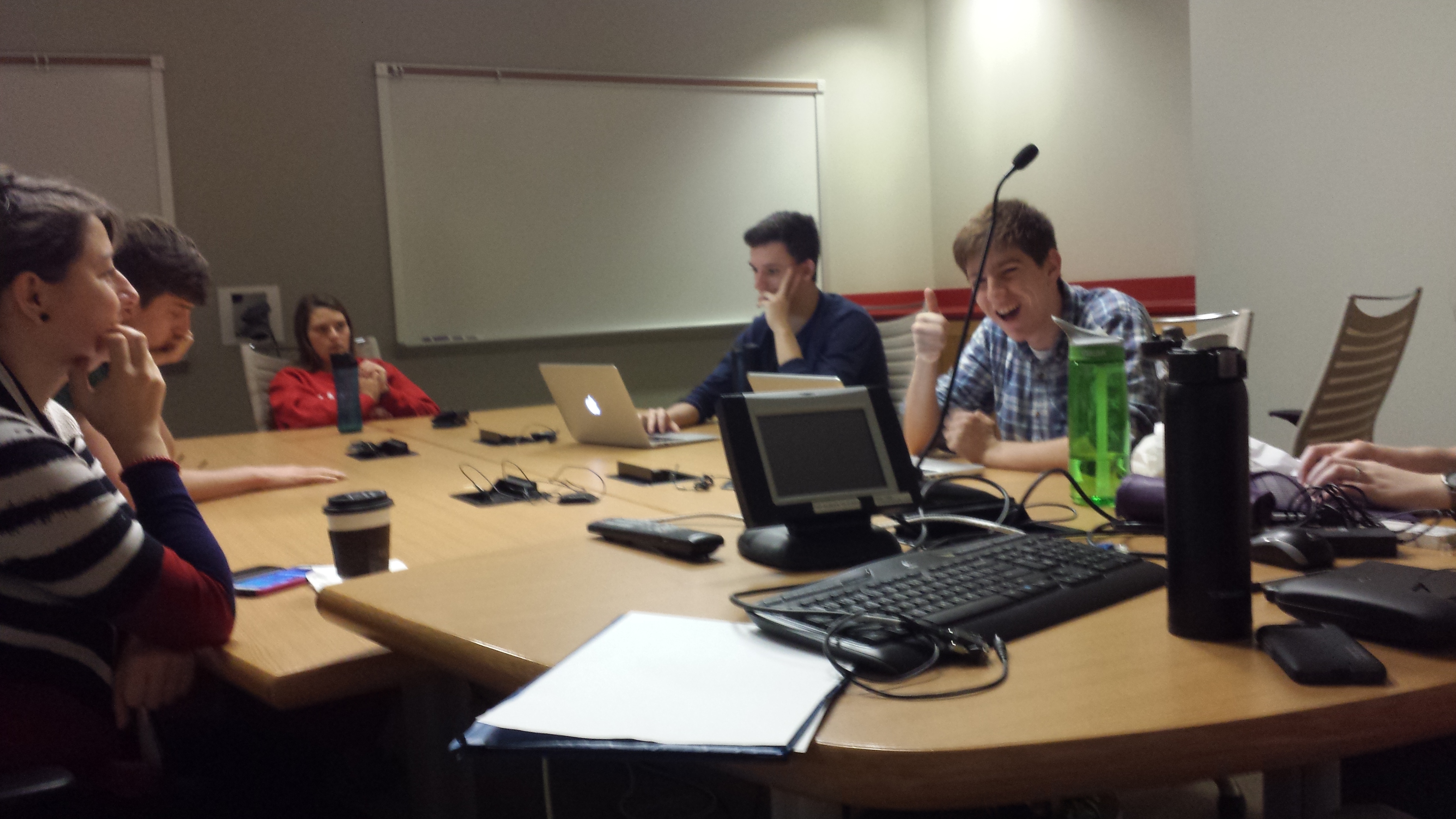
Human Practices
Think outside the bench
As a subsidiary of the Nitrogen Project, a multi-university initiative to end nitrate pollution, our focus for human practices was largely based on agriculture. In this page, we will cover the following in detail:
- The history of WashU-PSU iGEM teams and the Nitrogen Project
- Our conversation with Sarah Carlson, a project manager at the Practical Farmers of Iowa, who argued that synthetic biology could not end nitrate runoff
- Our interview of Ray Erhardt, an aquatics engineer, who thought that nitrate runoff must be dealt upstream of wastewater plants and in the fields themselves
- We spoke with members of the St. Louis County Soil and Water Conservation District Board and the Missouri Coalition for the Environment, who both believed other, natural solutions to excessive fertilizer use could be more effective than synthetic biology
- We interacted with scientists and researchers at Monsanto and Intrexon who suggested new approaches to our project and backed our research and mission
- Our time spent interacting with future STEM students and high school teachers at Wash U and Missouri S&T and teaching them about synthetic biology
Project Formation

For the past two years, the WashU-PSU iGEM team has been working to progress the Nitrogen Project. In our first group meetings, we had to determine if we, too, wanted to contribute. Both of the previous teams worked on finding the genes necessary for expressing nitrogen in E. coli. However, they had limited success – one team claimed to find nitrogenase activity, but the results were never replicated. The other never succeeded in constructing their complex plasmids. However, we didn’t want to abandon their work and shirk the resources and knowledge of the professors and graduate students who we would be working alongside all summer. So we tried to carve out a new niche in the Nitrogen Project for ourselves – and we looked outside Wash U for help.
Enter Sarah Carlson, a project manager at the Practical Farmers of Iowa. Initially, we called her to get a better idea of the environmental consequences of nitrate fertilizer runoff in the Midwest. We explained that the Nitrogen Project aimed to eliminate fertilizer use altogether. Contrary to how we thought she’d respond, Carlson stated that fertilizer was not the battle to fight. Nitrates leak from the soil regardless of fertilizer use and, instead, we should work to plant cover crops to soak up the excess.
This had a very strong impact on our direction for the project. If nitrogen-fixing plants won’t have the world-changing impacts we believe, were there other problems we could tackle with research that fit within the bounds of the nitrogen project? What other applications weren’t we considering?
After our conversation with Carlson, we took a closer look at the cellular conditions necessary for nitrogenase function. While we were still motivated to work on the Nitrogen Project, our scope was now adjusted. Perhaps we could make a cell that would improve nitrogenase’s function, but avoid the laborious task of actually inserting nitrogenase’s genes. We thought that a cell with the perfect conditions for nitrogenase could also be used with other recombinant proteins – we’d just have to select the right conditions to improve.
While our new project still fit into the scope of the Nitrogen Project and we continued to understand the impact of nitrate runoff in the agricultural regions around St. Louis, we also began to consider other applications of our research. We contacted companies that use synthetic biology for more industrial purposes, and asked them to comment on how our “supercharged” cells could be practically utilized.
Nitrate Runoff and the Midwest


To begin our education on nitrate runoff, we began with faculty within WashU in St. Louis. At first, we requested time with Ray Ehrhardt, a professional engineer with a position in the department of Energy, Environmental, and Chemical Engineering. Ray’s experience lay in devising water filtration and management systems. Nitrate runoff, he said, is excruciatingly difficult to filter out on a large scale. Nitrate runoff has well documented side effects including algal blooms and “blue baby syndrome” in children, but can only be removed via energy intensive processes like distillation or reverse osmosis filtration. Water contamination from agriculture, he said, is best dealt with upstream of filtration. Otherwise, the aqueous pollution becomes very costly to remove. Mr. Erhardt had several contacts in the St. Louis area, and suggested we reach out to other regional authorities.
We contacted the St. Louis County Soil and Water Conservation District Board, the governing body encouraging sustainable farming practices in our area. They invited us to one of their monthly board meetings, where they commented on the usefulness of our project. The crux of excess nitrate runoff isn’t agriculture, they said. Instead pet waste and other urban runoff can contribute a surprising amount of pollutants that aren’t as heavily publicized. As for the runoff that does occur from plants, the popularized notion of “industrial farms” spraying millions of gallons of fertilizer isn’t necessarily true. Most farms in the midwest are privately owned and operated they said, and it is entirely possible to get these farmers to adopt practices that they believe can mitigate runoff. While a GMO may be useful, they thought it wasn’t the only option, and certainly not the most effective.
Next, we reached out to the Missouri Coalition for the Environment. They are a small nonprofit organization that educates farmers on sustainable practices and lobbies for legislation to minimize ecological pollution. Opposed to GMOs, they advocated for other sustainable methods of providing fertilizers to crops – most poignantly, the unused resource of livestock manure that is plentiful in the midwest. They noted that there is little movement in the local and federal legislature to slow the growth of the agricultural companies that pollute the most – therefore the MCE travels all over the country to lobby for the reforms they promote. From this experience, we learned that the runoff crisis stretches further than simply a dearth of new agricultural technologies. While we were still motivated by this original application of our research, we began to seek out new venues for its use.
Industry
Finally, we sought out advisors who could comment on the use of our supercells beyond an agricultural setting. We wanted to know how ATP overproduction could specifically be utilized to produce recombinant proteins, improve cell growth, etc. We began by visiting Monsanto, whose largest research facilities are centered about St. Louis. There, we spoke with over a dozen scientists about our super cells and received comments about potential applications. One suggestion was that our cells could output ATP in a reactor for other cells’ use. In a way, our cells could act as a source of fuel for ATP-intensive processes in other cells. A scientist also suggested we search for ferredoxin and flavodoxin via a spectroscopy analysis. While our lab was not equipped for the method he suggested, we were inspired to use our spectrometer to get a rudimentary idea of ferredoxin and flavodoxin concentrations.
Intrexon, another sponsor of the WashU-PSU iGEM team, allowed us to speak with one of their lead microbiologists. He offered insight into some of our unusual results. The reddish coloration of our cultures overproducing ferredoxin was likely the result of reduced cytochromes in our cells. In future work, we think a cytochrome assay could prove more indicative of reduced electron donor concentration than a biotin assay. In addition, he suggested new applications for our super cells. Sulfur-containing polypeptide chains would benefit from higher ATP concentrations, so our cells could potentially be utilized for specialized recombinant protein production. From his advice, we recognized that our strain had varied applications in industry as well as agriculture.



Engagement


Throughout the course of our project, we sought to apply our knowledge of synthetic biology through education wherever possible:
- We led two synthetic biology workshops for Washington University’s pre-engineering institute. This summer program allows a group of approximately 30 students to do an experiment in each of the engineering school’s main divisions.
- We discussed our project with local teachers participating in a BioBuilder workshop. We found that the teachers were enthusiastic about including synthetic biology in their curriculums.
- We helped run a “Building with Biology” event at the iGEM heartland regional meetup with our buddies over at UNL and Missouri S&T.






